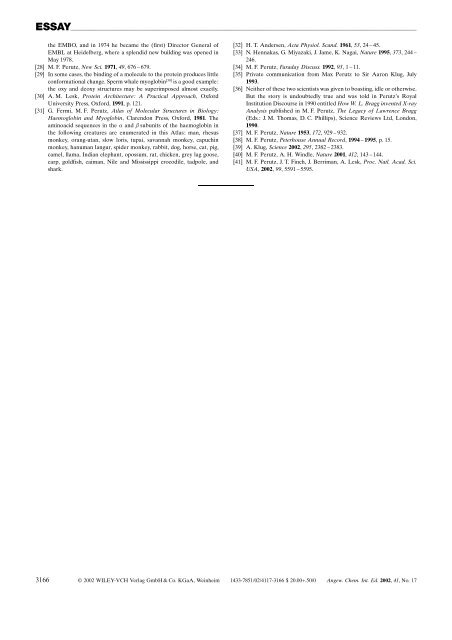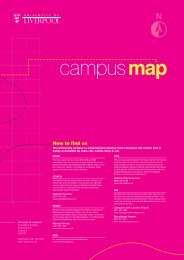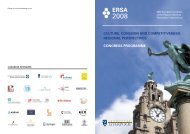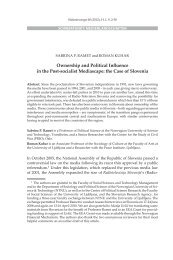The Scientific and Humane Legacy of Max Perutz - Molecular ...
The Scientific and Humane Legacy of Max Perutz - Molecular ...
The Scientific and Humane Legacy of Max Perutz - Molecular ...
Create successful ePaper yourself
Turn your PDF publications into a flip-book with our unique Google optimized e-Paper software.
ESSAY<br />
the EMBO, <strong>and</strong> in 1974 he became the (first) Director General <strong>of</strong><br />
EMBL at Heidelberg, where a splendid new building was opened in<br />
May 1978.<br />
[28] M. F. <strong>Perutz</strong>, New Sci. 1971, 49, 676 ± 679.<br />
[29] In some cases, the binding <strong>of</strong> a molecule to the protein produces little<br />
conformational change. Sperm whale myoglobin [30] is a good example:<br />
the oxy <strong>and</strong> deoxy structures may be superimposed almost exactly.<br />
[30] A. M. Lesk, Protein Architecture: A Practical Approach, Oxford<br />
University Press, Oxford, 1991, p. 121.<br />
[31] G. Fermi, M. F. <strong>Perutz</strong>, Atlas <strong>of</strong> <strong>Molecular</strong> Structures in Biology:<br />
Haemoglobin <strong>and</strong> Myoglobin, Clarendon Press, Oxford, 1981. <strong>The</strong><br />
aminoacid sequences in the a <strong>and</strong> b subunits <strong>of</strong> the haemoglobin in<br />
the following creatures are enumerated in this Atlas: man, rhesus<br />
monkey, orang-utan, slow loris, tupai, savannahmonkey, capuchin<br />
monkey, hanuman langur, spider monkey, rabbit, dog, horse, cat, pig,<br />
camel, llama, Indian elephant, opossum, rat, chicken, grey lag goose,<br />
carp, goldfish, caiman, Nile <strong>and</strong> Mississippi crocodile, tadpole, <strong>and</strong><br />
shark.<br />
[32] H. T. Andersen, Acta Physiol. Sc<strong>and</strong>. 1961, 53, 24 ± 45.<br />
[33] N. Hennakas, G. Miyazaki, J. Jame, K. Nagai, Nature 1995, 373, 244 ±<br />
246.<br />
[34] M. F. <strong>Perutz</strong>, Faraday Discuss. 1992, 93, 1±11.<br />
[35] Private communication from <strong>Max</strong> <strong>Perutz</strong> to Sir Aaron Klug, July<br />
1993.<br />
[36] Neither <strong>of</strong> these two scientists was given to boasting, idle or otherwise.<br />
But the story is undoubtedly true <strong>and</strong> was told in <strong>Perutz</strong>×s Royal<br />
Institution Discourse in 1990 entitled How W. L. Bragg invented X-ray<br />
Analysis published in M. F. <strong>Perutz</strong>, <strong>The</strong> <strong>Legacy</strong> <strong>of</strong> Lawrence Bragg<br />
(Eds.: J. M. Thomas, D. C. Phillips), Science Reviews Ltd, London,<br />
1990.<br />
[37] M. F. <strong>Perutz</strong>, Nature 1953, 172, 929 ± 932.<br />
[38] M. F. <strong>Perutz</strong>, Peterhouse Annual Record, 1994 ± 1995, p. 15.<br />
[39] A. Klug, Science 2002, 295, 2382 ± 2383.<br />
[40] M. F. <strong>Perutz</strong>, A. H. Windle, Nature 2001, 412, 143 ± 144.<br />
[41] M. F. <strong>Perutz</strong>, J. T. Finch, J. Berriman, A. Lesk, Proc. Natl. Acad. Sci.<br />
USA, 2002, 99, 5591 ± 5595.<br />
3166 ¹ 2002 WILEY-VCH Verlag GmbH & Co. KGaA, Weinheim 1433-7851/02/4117-3166 $ 20.00+.50/0 Angew. Chem. Int. Ed. 2002, 41, No.17





